#saint louis ix
Text
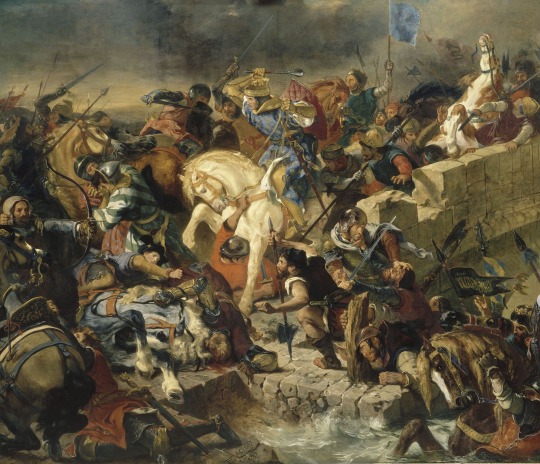
The Battle of Taillebourg, 21 July 1242 by Eugène Delacroix
#battle of taillebourg#art#eugène delacroix#middle ages#medieval#history#knights#france#louis ix#saint louis#french#europe#saintonge war#saintes#versailles#capetian#angevin#england#english#bridge#henry iii#charente#river#kingdom of france#kingdom of england#alphonse of poitiers#hugh x of lusignan#richard of cornwall#mace#king
100 notes
·
View notes
Photo


For Medieval craftsmen, work was an act of piety, sanctified in their own eyes as in the eyes of their God. For such labourers, end and means are one. The spiritual wholeness of faith is translated into the visual wholeness and purity of their craft.
- Roger Scruton
The Sainte-Chapelle is the finest royal chapel to be built in France and features a truly exceptional collection of stained glass windows. It was built in the mid 13th century by Louis IX, at the heart of the royal residence, the Palais de la Cité, to house the relics of the Passion of Christ. Adorned with a unique collection of fifteen glass panels and a rose window forming a veritable wall of light, the Sainte-Chapelle gem of Rayonnant Gothic architecture.
#scruton#roger scruton#quote#sainte-chapelle#church#architecture#design#gothic architecture#Louis IX#divine#spiritual#craft#medieval#beauty#aesthetics
218 notes
·
View notes
Text

Saint King Louis IX of France
1214-1270
Feast day: August 25
Patronage: Architects and Monastic third orders
Saint Louis IX was crowned King of France at age 12 and reigned until his death. His mother ruled the kingdom until he reached maturity and instructed him in his education and religion. Louis married Margaret of Provence in 1234 and they had 11 children. He saw himself as a “Lieutenant of God on earth” even obtaining Christ's crown of thorns from Baldwin II, Latin emperor at Constantinople. He was an exemplary king, protecting the poor and clergy, founding hospitals and the Abbey of Royaumount and built Saint-Chapelle, an architectural gem. He led two crusades in 1238 and 1267, where he died of the plague.

Prints, plaques & holy cards available for purchase here: (website)
78 notes
·
View notes
Text
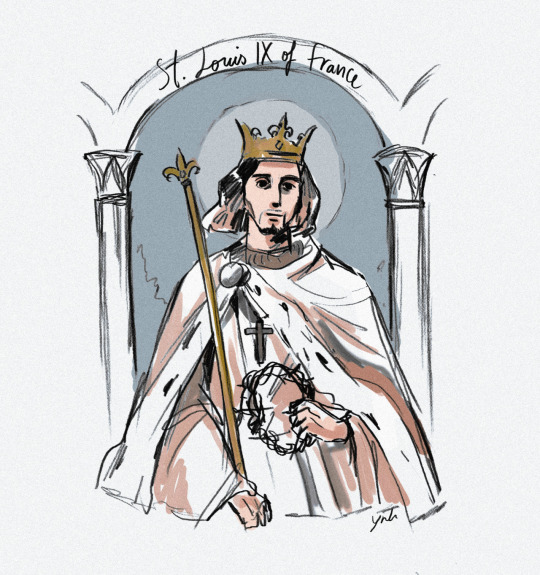
Saint Louis IX of France (1214-1270). French king who was renowned for his piety and charity.
220 notes
·
View notes
Text
La Reine Blanche de Castille et son fils Saint Louis

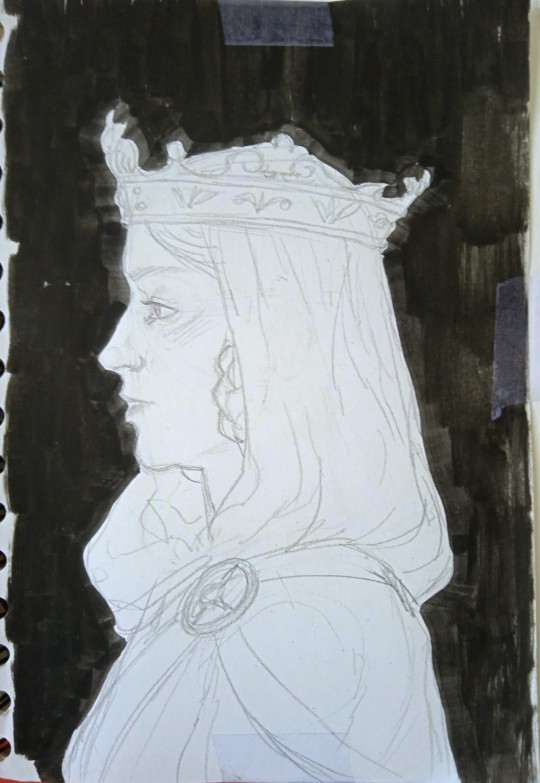
#Blanche de Castille#saint louis#st louis#louis ix#louis 9#roi de france#moi je dis roy de Franc#king of france#france#french history#aquarelle#watercolour art#art#queen of france#queen
47 notes
·
View notes
Text
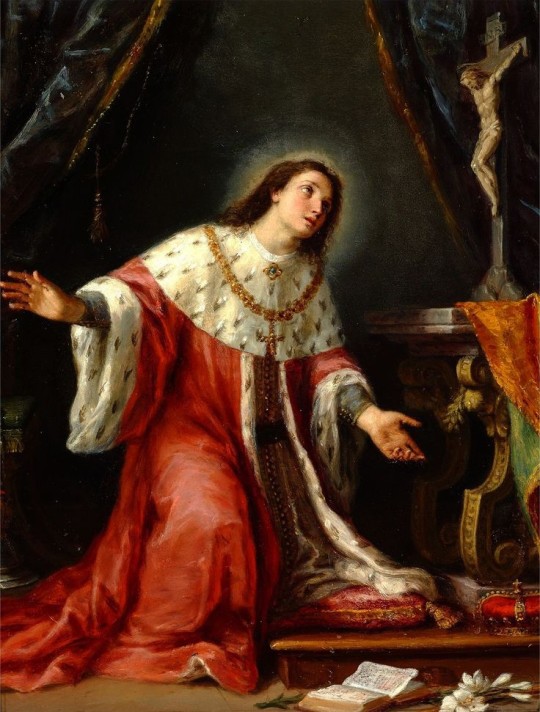
A renaissance era Catholic religious painting of St. Louis IX in prayer. I don't know who the artist is.
#traditional catholicism#traditional catholic images#traditional catholic renaissance religious art#traditional catholic saints#traditional catholic saints images#st. louis ix#traditional catholic saint royalty#king of france
7 notes
·
View notes
Text

St. Louis IX.
#stained glass#st louis#capétiens#louis ix#roi de france#vive le roi#crusades#kingdom of heaven#crusader#saints#catholic church#royaume de france
7 notes
·
View notes
Photo

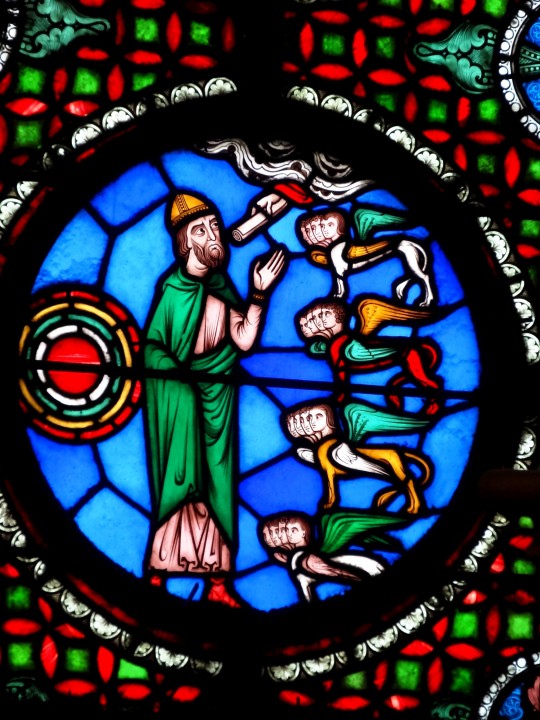




Je reviens à mon projet de présenter la plupart de mes 55000 photos (nouveau compte approximatif. On se rapproche du présent !).
2016. Une journée à Paris....et ici, un crochet à Saint-Denis pour visiter la Basilique, qui est aussi la nécropole royale.
En 1er et dernier, de part et d’autres des photos des chapelles: les gisants de Jean et Blanche de France, enfants de Saint Louis
#souvenirs#paris#saint-denis#basilique de saint-denis#art gothique#médiéval#nécropole#nécropole royale#chapelle#vitrail#vitraux#rois de france#saint louis#louis IX#louis de france#jeanne de france#or#monstre
23 notes
·
View notes
Photo

(Via littleflowerfaith)
18 notes
·
View notes
Text

THE DESCRIPTION OF SAINT LOUIS IX OF FRANCE
Feast Day: August 25
Louis IX, who ruled France from 1226 to 1270, the most illustrious of the Direct Capetians, known as Louis the Saint and the only canonized king of France, was born in Poissy, near Paris, on April 25, 1214. His mother, Blanche of Castile, trained him to be a great leader and a good Christian.
She used to say: 'I love you my dear son, as much as a mother can love her child; but I would rather see you dead at my feet than that you should ever commit a mortal sin.'
During Louis' childhood, Blanche dealt with the opposition of rebellious vassals and secured Capetian success in the Albigensian Crusade, which had started 20 years earlier.
Made king of France when he was only 12 years old after the death of his father, Louis VIII (Louis the Lion), he revealed exceptional human and administrative qualities. Everything he did was for the glory of God and for the good of his people. On May 27, 1234, at 19, he married Margaret of Provence, who gave him eleven children.
He protected the poor, forbade usury, and was never heard to speak ill of anyone. He excelled in penance and had a great love for the Church. Louis was merciful even to rebels.
When he was urged to put to death a prince who had followed his father in rebellion, he refused saying: 'A son cannot refuse to obey his father.'
Louis used these anti-usery laws to extract funds from Jewish and Lombard moneylenders, with the hopes that it would help pay for a future crusade. Louis also oversaw the Disputation of Paris in 1240, in which Paris's Jewish leaders were imprisoned and forced to admit to 'anti-christian' passages in the Talmud, the major source of Jewish commentaries on the Bible and religious law.
In 1250, he headed a crusade into Egypt, but was taken prisoner. During his captivity, he recited the Divine Office every day. After his release against ransom, he visited the Holy Land before returning to France. In these deeds, Louis IX tried to fulfill what he considered the duty of France as 'the eldest daughter of the Church' (la fille aînée de l'Église), a tradition of protector of the Church going back to the Franks and Charlemagne, who had been crowned by Pope Leo III in Rome in 800. The kings of France were known in the Church by the title 'most Christian king' (Rex Christianissimus).
Louis embarked on another crusade, but got sick and died near Carthage in an epidemic of dysentery that swept through his army. Louis was 56 when he died in 1270.
In his spiritual testament, he wrote: 'My dearest son, you should permit yourself to be tormented by every kind of martyrdom before you would allow yourself to commit a mortal sin.'
He is honored as co-patron of the Third Order of St. Francis, which claims him as a member of the Order. When he became king, over a hundred poor people were served meals in his house on ordinary days. Often the king served these guests himself. His acts of charity, coupled with his devout religious practices, gave rise to the legend that he joined the Third Order of St. Francis, though it is unlikely that he ever actually joined the order.
2 notes
·
View notes
Text

2 notes
·
View notes
Text
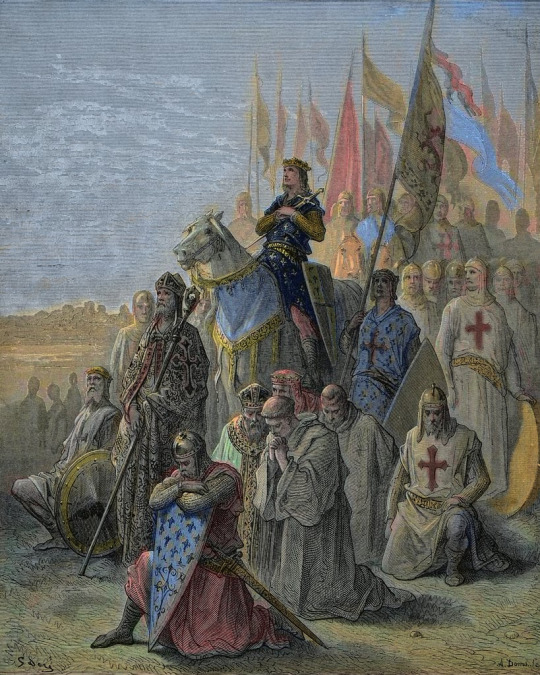
St Louis before Damietta (Seventh Crusade)
by Gustave Doré
#st louis#saint louis#louis ix#king#france#seventh crusade#art#gustave doré#damietta#egypt#north africa#crusade#crusades#crusaders#crusader#medieval#middle ages#knights#knight#europe#european#history#history of the crusades#joseph francois michaud#christianity#christian#religion#religious#religious art
197 notes
·
View notes
Text
SAINT OF THE DAY (August 25)

St. Louis was born on 25 April 1214 to King Louis VIII and Blanche of Castile at Poissy.
His grandfather on his father's side was Philip II, king of France; his grandfather on his mother's side was Alfonso VIII, king of Castile.
Louis was made king at only 12 years of age. He was the father of 11 children. He led an exemplary life, bearing constantly in mind his mother's words:
"I would rather see you dead at my feet than guilty of a mortal sin."
His biographers have written of the long hours he spent in prayer, fasting and penance, without the knowlege of his people.
The French king was an avid lover of justice, who took great measures to ensure that the process of arbitration was carried out properly.
All of 13th century Christian Europe willingly looked upon him as an international judge.
He was renowned for his charity. "The peace and blessings of the realm come to us through the poor," he would say.
Beggars were fed from his table. He ate their leavings, washed their feet, ministered to the wants of the lepers, and daily fed over one hundred poor.
He founded many hospitals and houses: the House of the Felles-Dieu for reformed prostitutes, the Quinze-Vingt for 300 blind men (1254), as well as hospitals at Pontoise, Vernon, and Compiégne.
St. Louis was patron of architecture, masons and builders.
The Sainte Chappelle, an architectural gem, was constructed in his reign as a reliquary for the Crown of Thorns.
It was under his patronage that Robert of Sorbonne founded the "Collège de la Sorbonne," which became the seat of the theological faculty of Paris, the most illustrious seat of learning in the medieval period.
St. Louis died of the plague on 25 August 1270, near Tunis, during the Second Crusade.
Pope Boniface VIII proclaimed the canonization of Louis on 11 July 1297.
He is the only French king to be declared a saint. He is often considered the model of the ideal Christian monarch.
0 notes
Text


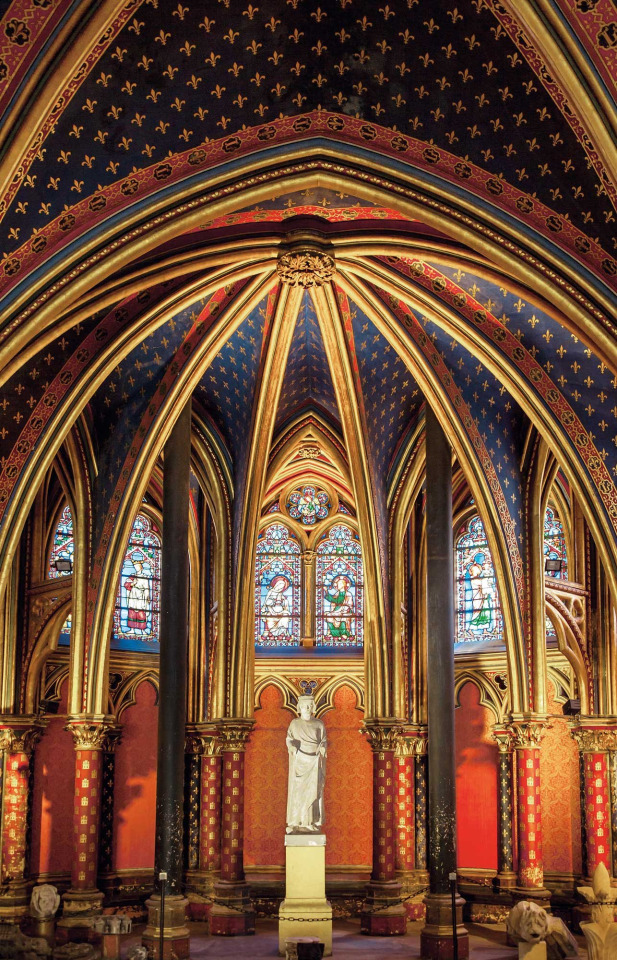



Sainte-Chapelle, the jewel of the Gothic.
Louis IX of France nicknamed the Saint, son of Blanca de Castilla (in turn daughter of Alfonso VIII and Eleanor de Plantagenet) and Louis VIII, has been considered the ideal of the medieval Christian monarch, a very devout king who dedicated his life to prayer, charity and asceticism... in addition to being the last European king to participate in the last two crusades: the Seventh between 1248 and 1254 and the Eighth in 1270, he took Saint Louis to Tunis and there he would die of the plague at the age of 56 and 40 of reign. In 1297 he will be canonized by Pope Boniface VIII.
His devotion and religiosity led him to acquire numerous relics and among them the coveted crown of thorns of Christ. Brought to France from Constantinople, Louis IX decided to organize a sacred place to keep and protect the holy collection. Thus in 1242 the construction of the Sainte-Chapelle would begin, which was consecrated in 1248. Little is known about the authorship of the chapel, it has been attributed to Pierre de Montreuil, master of the radiant Gothic and main architect of the reign of Saint Louis.
The enclosure was conceived as a reliquary or jewelry box where to deposit the precious and holy relics of the Passion of Christ. The chapel is 36 m long, 17 m wide and over 42 m high.
Its walls covered with precious stained glass windows, 15 in total, have representations, among other themes, of the Old Testament as well as the transfer of the crown of thorns to Paris.
These large openings filter the light, causing it to break down into different colors, symbolizing divine power and turning the place into a sacred and spiritual space. It is a large glass urn whose slender ribbed vaults, 20 m high, rise as if bringing us closer to God. In 1630 it went up in flames, a great fire destroyed it to a large extent and during the French Revolution its relics were stolen and many destroyed by the revolutionaries. Some were saved and are now kept in the treasury of Notre Dame Cathedral. In the S. XIX was the object of an extraordinary restoration, but preserving the spirit, fidelity and medieval beauty that it had in its origin.
172 notes
·
View notes
Text

Hersend (fl. 1249-1259) was a physician known for accompanying King Louis IX of France on the Seventh Crusade.
A skilled and trusted doctor
The document mentioning Hersend calls her magistra (the feminine form of magister, "master" or "teacher" in Latin), which could mean that she was university educated. This would be surprising since women technically couldn't attend universities at that time.
Hersend was a valued member of the royal household. A royal act dating from August 1250 promises her a lifelong pension of twelve Parisians deniers a day. Even if it can’t be known if she was the king’s personal physician, she likely took care of him during the expedition. Since Queen Margaret of Provence gave birth in 1250, Hersend could also have acted as a midwife.
Going back home
Hersend survived the dangers of the crusade (which saw the king captured and ransomed). She returned to Paris at the end of 1250, married an apothecary named Jacques and continued practice her profession. They bought a house together in 1259. Hersend was likely dead by 1299 and her house was bought by lady Pétronille, apothecary to the King of France.
Further reading:
"Hersende" - Les guerriers du Moyen-Âge
Kostick Conor, The Crusades and the Near East - Cultural histories
Le Goff Jacques, Saint Louis
Whaley L., Women and the Practice of Medical Care in Early Modern Europe, 1400-1800
#hersend#doctors#history#women in history#women's history#france#french history#13th century#middle ages#medieval women#medieval history#crusades#women in medicine
36 notes
·
View notes
Text
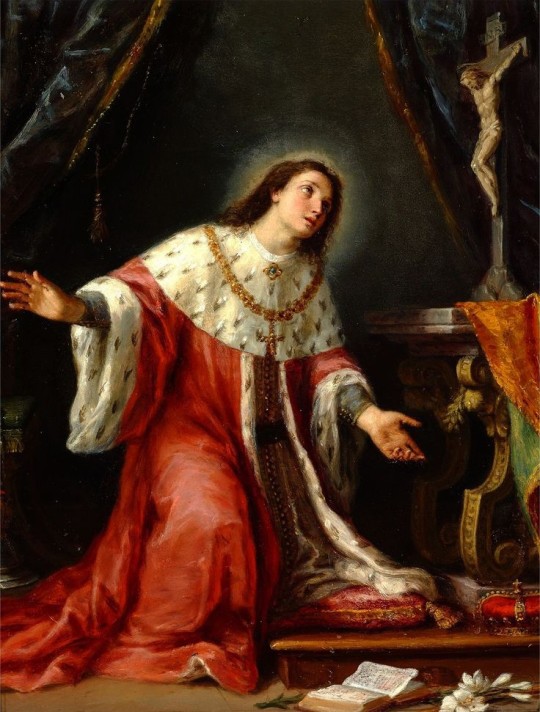
A renaissance era Catholic religious art image of St. Louis IX King of France praying before the Crucifix. I don't know who the artist is.
#traditional catholicism#traditional catholic images#traditional catholic renaissance religious art#traditional catholic saints#traditional catholic saints images#st. louis ix#traditional catholic royalty saints#king of france#traditional catholic history
3 notes
·
View notes